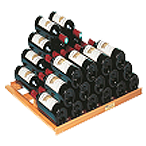Wine Tasting Guide
Our 9-step approach to getting the most out of your wine tastings.
The Bottlecru Wine Tasting Guide, outlined below, offers a professionally crafted approach to wine tasting. Follow the simple step-by-step instructions to appreciate the subtleties of what a wine has to offer you. Enhance your wine tasting experience and learn to quickly recognize whether a wine matches your palate and preferred wine styles. Check out this and more guides in the BottleCru app.
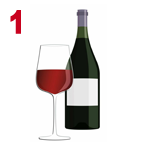
The Set Up
Ready to taste some wine? Great!
First, make sure that your environment is free from perfumes, cooking smells, pet odors or anything that would significantly affect your sense of smell. Sounds obvious, but use clean glassware. If your glass smells musty, rinse it out with wine, not water It will not only remove the smell but enhance the strength of the wine’s aroma. Oh, and you’ll want to have enough light so that you can clearly see the wine. We’ll go into this later, but you can tell a lot about a wine’s age and condition if you know what to look for.
For most still wines, use bowl shaped glasses with a stem. They’re designed so that you can swirl your wine without spilling or unintentionally warming it with your hand. Narrow, tall fluted glasses are perfect for showcasing the bubbles in sparkling wines.
| Still wine: Use glasses with bowls & stems to swirl the wine without spilling and keep your hands from warming it. |
| Sparklers: Use a fluted glass to better enjoy the bubbles. |
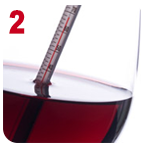
Temperature
Serving temperature will dramatically affect your tasting experience. Use the recommended ranges we provide in the guide, or experiment to find your own preference.
Increasing a wine’s temperature brings out its aromas and enhances the perception of alcohol, while chilling it tends to make the wine crisper and reduces its aroma and taste. Don’t mistake the outer temperature of the bottle for that of the wine inside. The two can be quite different and it takes time to match them.
If the wine seems too warm, please don’t use ice cubes to chill it down. This will change the wine’s taste balance and make evaluating it objectively next to impossible. Pop it in the fridge or freezer for a few minutes or use an ice bucket with water.
If it’s too cold, pour the wine into a room temperature decanter or into your glass and wait for it to warm. A wine will warm 1 degree for about every 3 minutes in the glass. You can also put your hands around the bowl of the glass to accelerate the warming.
| Sparklers, Cold 43⁰-50⁰, 5-10 minutes out from frig. Temperature or about 3 hours in the frig. before serving |
| Lighter Body Whites & Rosés, Chilled 45⁰-50⁰, 10-15 minutes out from frig. temp, or about 2 hours in the frig. before serving |
| Heavier Whites & Lighter Reds, Slightly Chilled 50⁰-55⁰, 30 minutes out from frig. Temp or 1.5 hours into frig. Before serving |
| Medium Body Reds Wine, Cellar Cool 55⁰-62⁰, 1 hour in the frig. before serving. |
| Full Body Reds, Cool Room 59⁰-65⁰, 20 minutes in frig. before serving |
| Still wine: Use glasses with bowls & stems to swirl the wine without spilling and keep your hands from warming it. |
| Sparklers: Use a fluted glass to better enjoy the bubbles. |
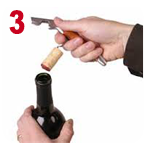
Pop The Cork
Most wines have a foil wrapper around the closure. Many are so loose you can just pull them off, but you’ll probably need to use a knife. Cut right below the second lip of the bottle. Once you’ve removed the cork, using your tool of choice, wipe any remaining particles that might have collected around the mouth of the bottle. If your bottle has a screw cap, you’re already a step ahead and don’t need to worry about the foil or the cork. BTW Screw caps are just fine for newer wines that are opened and drunk young.
You might notice clear particles on the bottom of the cork. These are tartartic acid crystals that form if the wine was significantly chilled during storage. Some red wines also have sediment, known as deposits, on the cork, clinging to the insides of the bottle or even floating in the bottle. These are all harmless. You can either ignore them or separate them out by decanting the wine.
Opening sparkling wines can be a bit trickier. Those wine are often under significant pressure, so keep your thumb on top of the cork at all times. Untwist the wire cage tab six turns counterclockwise. While keeping your thumb and hand on the cork, spread the wire cage, but don’t take it off, yet!
Keeping the bottle at a 45º angle, pointed away from everyone in the room, grasp the cork and cage with one hand and the twist the bottom of the bottle with the other until the cork squeezes out. Be patient and listen for a hissing or sigh sound, not a dramatic pop, that’s unless you’re in the winning team’s locker room after the Super Bowl.

Pour A Taste
Pour about an ounce (2 fingers) of wine into your glass. To avoid dripping wine, roll your wrist as you finish pouring and use a napkin to catch any drips. You can also go the easy route and buy a pour spout. They come in many different styles, but they all ease the process. Oh, if you’re pouring red wines, consider keeping some Wine Away® wine stain remover on hand to handle any accidental spills. You’ll thank us later!

Sight The Wine
In good light, hold the wine glass at an angle against a white background and notice its color. Look at the wine’s core and it’s rim. You can get some clues about the wines freshness and age. Red wines get lighter with age, while white wines get darker. For both, the rims get wider with age. As you taste more, you’ll learn to appreciate how age affects wine.
Now, swirl the wine so that it covers the inside of the glass. To avoid spilling, you can place your glass on a flat surface and move it in a brisk circular motion.
The streaking droplets of fluid on the inside of your glass are called legs. Wines with thicker and slower descending legs are typically higher in alcohol and fuller in body and feel thicker in the mouth.
If you’re tasting a sparkler that’s missing energetic bubbles, you might be using glassware with some residual detergent. Try the wine in another glass that’s been rinsed and dried properly.

Smell The Wine
To get a proper whiff, hold the glass to your nose and breath in.
If you’re nosing a red wine, you might smell a wide range of red & black fruits and berries that are either fresh, dried or cooked. Take another smell and notice any floral notes such as white flowers, sweet fruit blossoms to roses and violets. Finally, take one more smell and notice the wine’s earthy and spice characteristics; ranging from fresh green herbs, baking spices, smoke and tree nuts to mushroom, forest floor and vegetal notes.
If you’re nosing a white wine, you might smell tree fruit from apples, pears, or citrus such as lemon, lime, and grape fruits, Or you might smell stone fruits such as peaches and apricots or tropical fruits such as pineapple, kiwi, mango or even banana. White flowers, honeysuckle or rose petal aromas may be there as well. See if you can smell some green herbs such as bell pepper or even some fresh cut grass. Lastly see if you can smell any baking spices or even dairy or bread smells.
All of these aromas are attributable to specific grape varieties, which you’ll learn as you gain experience in wine tasting. It’s amazing what aromas wine can deliver!
| Smell for fruit aromas ranging citrus, tree fruits, berries and tropical fruits |
| Smell for flower aromas ranging from white flowers, sweet fruit blossoms to roses & violets. |
| Smell for spices and earth aromas ranging from herbs, baking spices, nuts, vegetal, forest floor to mushroom aromas. |
| However, if you smell wet & moldy cardboard smells means the wine’s “corked” and flawed and should be returned to the source. |

Look For Faults
Unfortunately, there are several ways that a wine can go bad. Rather than explore the causes, we’ll focus for now on how to identity the most common ones and what you can do to remedy the situation.
If your wine smells like wet cardboard or a wet basement it’s “corked”. It’s actually a smell that comes from a contaminated cork and will only get worse with air.
If the wine smells like; vinegar, fingernail polish, garlic, onion, rotten eggs or a strong barnyard, it’s also flawed. If a wine smells like Sherry, but is actually some other wine variety, it’s also flawed.
Sulfur or burnt matches with a white wine indicates an excess of sulfur used as a preservative. Try swirling the glass to see if it blows off. Chances are it will. If not, you guessed it! It’s flawed.
So, what to do with all this flawed wine? If you’re in a restaurant, simply grab the attention of your server. She’ll take the wine back and set you up with a proper glass or bottle. If you have a store-bought wine that’s flawed, the process may be a bit trickier. Be sure to ask a store manager about their return policy for flawed wines.
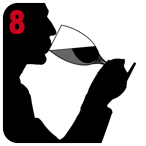
Take A Taste
Ah, the moment you’ve been waiting for. Take a full taste. Move the wine around in your mouth so that it coats your tongue. Give it a moment or two to warm and release all its aromas. Notice if the wine tastes sweet, meaning sugary, or dry, as in not sugary. Swallow, wait and then exhale gently through your nose. This is a great way to detect all the aromas the wine can deliver. Remember, your sense of smell is far more dynamic than your sense of taste.
Now, remember all those aromas you sensed when you first smelled the wine? Do you notice any additional fruit flavors now that you’ve actually tasted it? Are they ripe or un-ripe? Dried or cooked? Do you taste citrus, tree fruits, berries, tropical or vine fruits? What about earth and spice notes? Things like fresh herbs, baking spices, nuts, vegetal flavors, forest floor or mushrooms?
Notice the texture of the wine on your tongue. Is it silky smooth or slightly rough like sand paper? Feel heat on the back of your tongue? That’s caused by the alcohol in the wine. Note the weight and body of the wine. In other words, does it feel heavy or light on your palate?
After you’ve had a few tastes, wait for a moment and see how long the finish lasts. Is it strong? Does it persist or simply drop off? Finely crafted wines have longer, more complex finishes.

Rate & Share
Take a snapshot of the wine label using the BottleCru app and then give it a 1 to 5 star rating. Makes some notes to help you remember the aspects of the wine you may or may not have enjoyed. This will create a personal tasting history of every wine you try, allowing you to share and compare tasting experiences with your friends and other BottleCru members. It will also enable us in the future to recommend wines you’ll enjoy.





